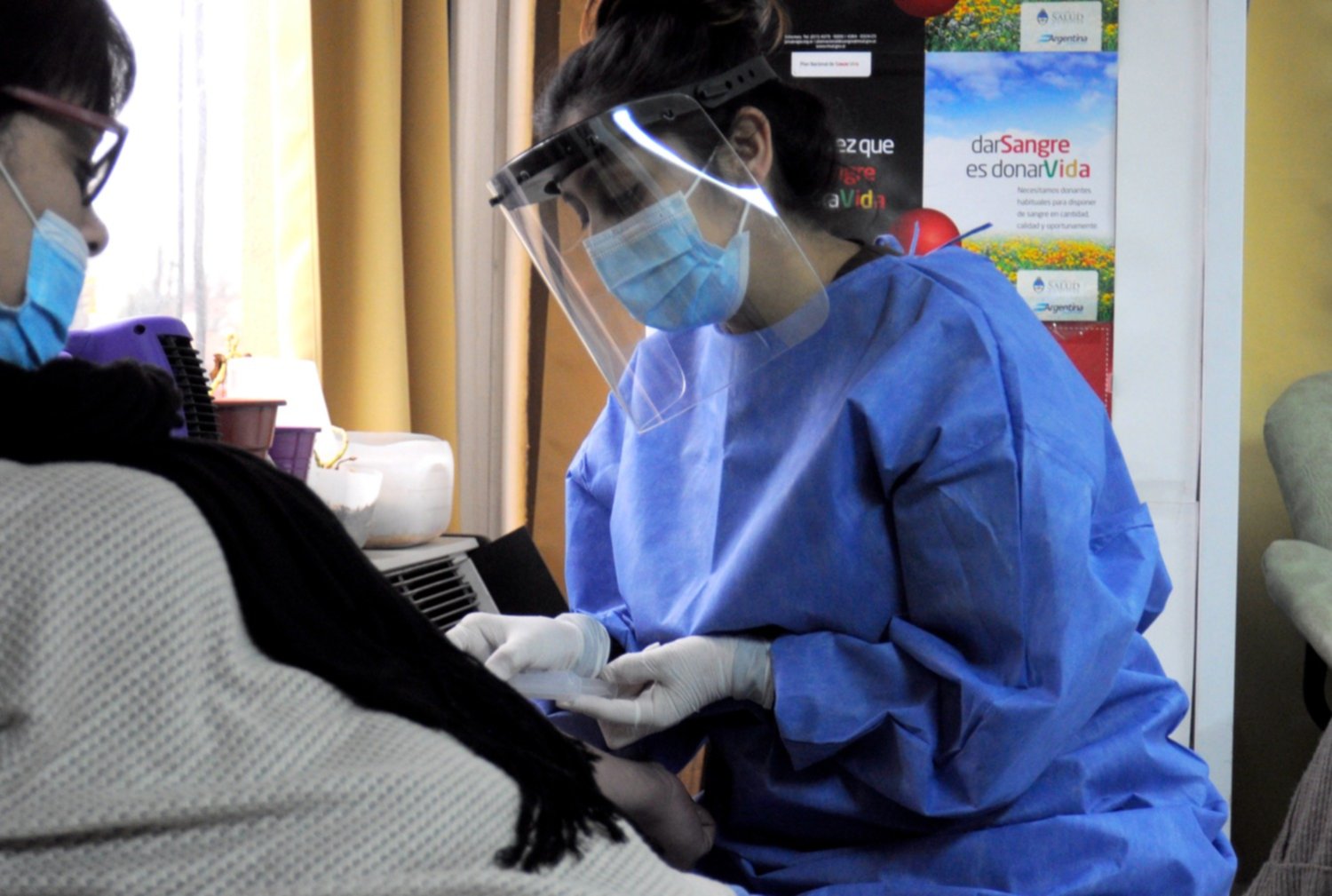Audio note: Romina Farias
By Mario Minervino / [email protected]
It was always difficult for hospitals to have the necessary amount of blood in their banks that would allow them to smoothly meet the demand for this key component when dealing with medical issues, especially emergencies, urgency or complications.
The pandemic has made this situation much more complicated and although the situation seems to be improving little by little, the need for voluntary donors is growing and the availability of blood is insufficient.
“Donating blood saves lives.” Rarely such a precise and forceful slogan to explain the importance of donating blood or, in other words, that medical centers have a blood bank adequate for daily needs.
According to what is stated on the website of the Ministry of Health of the Nation, each person who donates blood is saving at least four lives.
However, it has never been easy for hospitals to gather the necessary number of donors to ensure availability at the time of attending emergencies, even though it would even reach 3% of the population donating blood twice a year. to meet that demand.
In addition to this usual limitation, in the last two years an aggravating circumstance has been added when it comes to having donors. The Covid pandemic has severely complicated people’s willingness to go to hospitals to make that donation.
Because of the quarantine and mandatory isolation that governed in 2020, because of infections and because of the idea that a hospital is a place where the chances of contagion increase exponentially. That is why the situation has become more worrying in terms of the availability of blood in hospital banks.
complicated moment
The lack of donors is verified throughout the country and Bahía Blanca is no exception.
The doctor Isabel Gallez, head of the Hemotherapy Service of the Dr. José Penna Interzonal Hospital, told this newspaper that “a complicated moment” is going through in terms of the availability of blood, a bit more serious in the summer months, when in addition people go on vacation and the number of donors decreases.
“The wave of Ómicron (the new variant of Covid 19) ended up further complicating the panorama and only now are we slowly getting out of the worrying situation,” he added.
The need for more blood is still “important” and getting it depends largely on organizing donation campaigns to add volume.

“It has happened to us that 25 donors sign up and at the time of having to attend, half are absent due to Covid infection or being isolated due to close contact,” explained the professional.
Added to this is also a limitation in the available number of professionals who are in charge of drawing blood in the localities of the region, with which they cannot be added to the collections and simultaneously the demand from these populations grows.
Hospitals: safe place
One of the requests that is made from the Penna is that people go to the establishment, that they know that it is a safe place, where the chances of getting Covid are minimal.
“Today it is well known that the contagion will not be in a hospital. Because also, in our case, the donation room is in a corridor near the entrance, away from the guard area and the covid hospitalization area. There is no increased risk of contagion,” Gallez explained.
The professional stated that donations can be made every day of the week, from 8 a.m. to 11:30 a.m. and on Tuesdays and Thursdays from 1:30 p.m. to 3:00 p.m.
“Each hospital has the appropriate precautionary measures so that anyone can approach to donate,” he added.
On the other hand, he anticipated that in the remainder of February there will be several collections in different parts of the city, which in general have a good response and have served to largely cover the needs of the city and the region.
“We even invite all those who want to organize a collection – be it neighborhood clubs, gyms, schools, churches – to call us at the hospital so that we immediately put together an agenda and start it up,” he said.
Volunteers
The great objective of hospitals is to cover all of their needs with voluntary donors.
“Ideally, no one has to wait for a sick family member to go out and request blood. Because also in those moments is when you are busiest in resolving situations and attention times are very limited”.
That is why the great challenge, the doctor mentioned, is to generate “a change of mentality and culture”, which teaches the importance of donating blood from the first years of school.
“Understanding that it is an act of citizenship, of sharing the life and health that I have today and that a sick person needs it. That is the concept to instill: that the one who donates blood is not a hero, but that doing so is part of a normal activity, ”he added.
The biochemist Florencia Salustro, who works in the Epidemiology area of the municipality’s Health Secretariat, also mentioned that since the pandemic “voluntary blood donations have greatly decreased,” for which the municipality organizes periodic collection campaigns.
“With Ómicron the same thing happened as with previous waves. The difference is that during the period of compulsory isolation, much less surgery and care were performed, so the lack of blood was not so noticeable. Now it is getting back to normal in that sense and the amount of money in the banks is not enough,” he noted.
Myths and truths
There are several issues that surround blood donation, many of them installed as truths when they are not, others that remain as unsupported beliefs.
Voluntary donors can do so up to four times a year for men or three for women. Ideally, they should do it twice a year.
Those who have had Covid can donate ten days after discharge or three after vaccination.
The growing trend of tattoos and piercings does not invalidate those who do them to be a donor. In the case of the Penna hospital, it is requested that one year have elapsed since its completion.
All blood groups are required. It is not true that the most common groups are available: The need and lack covers all groups.
There is a prejudice of people with Rh (-) factor blood who do not donate because they state that they are reserving for a possible family need. “That is a misconception. Years can pass without this situation occurring and the person may have donated up to 20 times. The body is also responsible for replacing the red blood cells and the donor may have saved many lives with his decision.
The act of donation does not require more than half an hour and the donor can continue doing their daily activities without any inconvenience. You should only drink liquids before coming, eat fruit or toast with jam, as well as coffee or mate.
Those interested in being a donor can call 4811510 or 2915262649. “You don’t have to be afraid to come to the hospital, which is a safe place. If they should not be attentive to the campaigns and collections that we do outside the establishment, although the reality is that many times the need cannot wait for those collections.
Curiosities about blood
Not all human blood is the same but is classified by groups according to whether or not they have certain proteins – called antigens – in their red blood cells. The main blood types are classified with the letters are A, B, AB and with zero.
The other difference between blood types is the one that determines the Rhesus factor, popularly known as Rh. It is not that there are two factors, as its qualification seems to indicate, but that the presence or not of that protein on the surface of the red blood cells is analyzed. Its presence is indicated by the + sign, its absence by the minus sign. To be Rh negative is to lack that protein.
The most common blood in people is Zero Rh (+), at an average of 39%. It is followed by A (+), with 30%. Then all the percentages are clearly lower: AB (-), 1%; B(-); 2% is B(-); (A-) 6%; B positive (B+) 9%; AB positive (AB+) 4%
Zero negative blood is compatible with any blood type, which is why its donors are known as universal donors. This type of blood is essential in emergency situations, when there is no time to check the patient’s blood group.
The AB-positive blood type is known as “universal recipient” because a person with it can receive any blood type.
Luis Agote, a maker
At the beginning of the 20th century, with the discovery of blood groups, the first attempts to carry out transfusions were made, but they were faced with the situation that the blood coagulated (loses its liquidity turning into a gel), which prevented the good result of the technique.
In 1914, the Argentine doctor Luis Agote discovered the citrate method, which made blood incoagulable and allowed it to be available when needed.
The discovery coincided with the beginning of the First World War and the procedure saved thousands of lives on the battlefields. Agote decided not to patent his discovery, convinced that it belonged to all of humanity.
–


